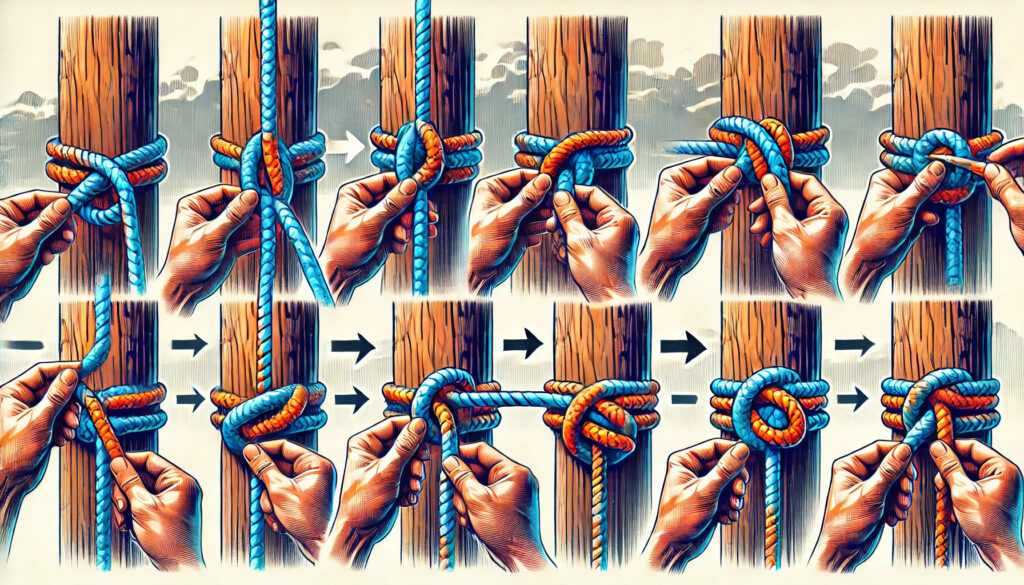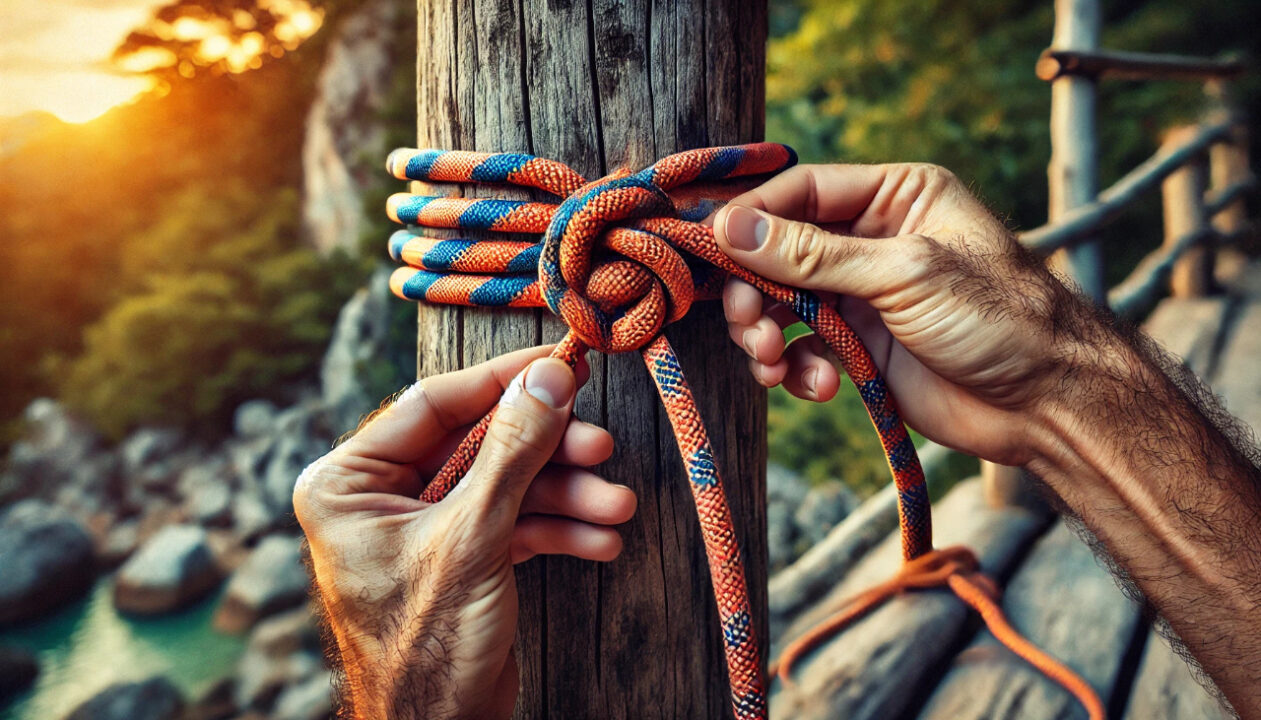The crock knot is a well-known knot that has become a reliable tool for outdoor enthusiasts. Whether you’re climbing, hiking, camping, or fishing, knowing how to tie the crock knot can come in handy in various situations. Its ability to secure loads, tie objects together, and provide stability in challenging environments makes it an essential knot for anyone who loves the outdoors. This guide will take you through everything you need to know about the crock knot, from its history to step-by-step instructions on how to tie it.
What Is the Crock Knot?
The crock knot is a type of binding knot known for its strength and ease of use. Unlike other knots that can be complex and difficult to untie, the crock knot is designed to provide a firm grip while also being easy to release when needed. Its versatility makes it an excellent choice for activities where safety and stability are paramount. The knot is most commonly used in outdoor settings, such as camping, climbing, and fishing, but it can also be applied in various household tasks.
You May Also Like: Ancient Artz: Unveiling Timeless Masterpieces
History of the Crock Knot
The crock knot has a rich history rooted in practical use. It was initially developed by sailors and fishermen who needed a reliable way to secure their equipment in harsh maritime conditions. Over time, its use spread to other areas, including climbing and rescue operations, thanks to its ability to hold under pressure and release quickly. The knot has evolved with the times, and modern climbers and outdoor enthusiasts have adopted it as one of the go-to knots for various applications.
Why Is the Crock Knot Essential?
The crock knot has many advantages that make it a must-know for anyone involved in outdoor activities. The knot provides excellent tension, which means it can hold heavy loads without slipping. It’s also easy to tie and untie, making it perfect for situations where you need to secure something quickly but also need to release it just as fast. Additionally, the crock knot is adaptable, working well with different types of ropes and materials.
How to Tie the Crock Knot

Learning how to tie the crock knot may seem intimidating at first, but with some practice, it becomes second nature. Below is a step-by-step guide to tying this versatile knot.
Step 1: Select Your Rope
The crock knot works best with medium to thick ropes, but it can be tied with almost any type of rope, from synthetic climbing lines to natural fibers used in camping. Choosing the right rope for your task will ensure that the knot holds firmly and does not slip under load.
Step 2: Make a Simple Loop
To start, take the rope and make a simple loop by crossing one end of the rope over the other. This is the foundation of your knot and needs to be stable before moving to the next step. The loop should be large enough to pass the end of the rope through it comfortably.
Step 3: Thread the Working End
Take the working end of the rope (the part of the rope that you’re manipulating) and pass it through the loop you just created. Pull the rope tight to form the beginning of the knot. This step will determine how tight or loose the knot will be, so adjust accordingly depending on the task at hand.
Step 4: Wrap Around the Standing End
Once you’ve passed the working end through the loop, wrap it around the standing end (the non-moving part of the rope). This wrap will help secure the knot and give it the tension it needs to hold firmly. Be sure to keep the wrap tight but not overly strained.
Step 5: Tighten and Secure
Finally, pull both ends of the rope to tighten the knot. Adjust it as needed to ensure it’s secure and won’t come undone easily. At this point, the crock knot should be complete, and you can use it to secure your equipment or perform other tasks.
Best Uses for the Crock Knot
The crock knot is useful in many situations, making it a go-to knot for outdoor enthusiasts. Here are some of the best uses for the crock knot:
Climbing
In the world of climbing, the crock knot is invaluable. It can be used to secure ropes, harnesses, and equipment, ensuring that everything stays in place during a climb. Its ability to hold firm under tension makes it a reliable choice for both amateur and professional climbers.
Camping
When camping, you may need to tie down tents, secure tarps, or fasten gear. The crock knot is perfect for these tasks because it provides stability and is easy to untie when it’s time to pack up camp. It also works well with natural fibers, which are often used in outdoor settings.
Fishing
Fishermen often use the crock knot to tie down nets, secure gear, and even fasten bait. Its simplicity and reliability make it a favorite among those who spend time on the water. Plus, it can easily be untied when you’re ready to release your catch.
Rescue Operations
In rescue operations, speed and reliability are crucial. The crock knot is often used by rescue teams to secure victims, fasten ropes for repelling, and tie down equipment. Its quick-release mechanism allows for fast adjustments when time is of the essence.
Everyday Household Use
The crock knot isn’t just for outdoor use. It can also be helpful around the house. Whether you’re securing a load in your vehicle, tying something to the roof of your car, or even fastening items in your garage, the crock knot provides a dependable solution.
Crock Knot vs. Other Knots
There are many types of knots, but the crock knot stands out for its ease of use and reliability. Below is a comparison of the crock knot with some other popular knots.
Crock Knot vs. Square Knot
The square knot is another simple knot often used in everyday situations. However, it doesn’t offer the same level of security as the crock knot. The square knot can slip under pressure, making it less reliable for heavy loads or critical tasks.
Crock Knot vs. Bowline Knot
The bowline knot is well-known for forming a fixed loop at the end of a rope. While the bowline is incredibly strong, it’s more difficult to untie than the crock knot. The crock knot’s quick-release feature makes it a better option for tasks that require frequent adjustments.
Crock Knot vs. Clove Hitch
The clove hitch is another versatile knot, often used for securing items. However, the crock knot offers more stability under tension, making it a better choice for heavy loads or critical applications.
Common Mistakes to Avoid When Tying the Crock Knot
Tying the crock knot is relatively easy, but some common mistakes can reduce its effectiveness. Here are a few pitfalls to avoid:
Over-Tightening
Pulling the rope too tight when forming the knot can make it difficult to untie later. Keep the tension firm but not overly tight.
Using the Wrong Rope
The crock knot works best with medium to thick ropes. Using a rope that’s too thin can cause the knot to slip or come undone under pressure.
Incorrect Loop Formation
Failing to make a proper loop at the start of the knot can result in a weak or unstable crock knot. Take your time when forming the initial loop to ensure it’s secure.
Tips for Mastering the Crock Knot
Mastering the crock knot takes practice, but with these tips, you can become an expert in no time.
Practice with Different Ropes
The more you practice tying the crock knot, the better you’ll become at it. Try using different types of ropes to see how the knot behaves with various materials.
Double Check Your Work
Before putting your knot to use, double-check it to ensure it’s tied correctly. A quick inspection can save you from having to re-tie the knot later.
Watch Video Tutorials
If you’re having trouble mastering the knot, consider watching video tutorials for visual guidance. Seeing the knot being tied in real-time can help you understand the process more clearly.
FAQs
What type of rope works best with the crock knot?
The crock knot works best with medium to thick ropes, such as climbing lines or camping ropes.
Is the crock knot easy to untie?
Yes, one of the advantages of the crock knot is that it’s easy to untie, even after bearing weight.
Can the crock knot hold heavy loads?
Yes, the crock knot is designed to hold heavy loads, making it a reliable choice for climbing, rescue operations, and other outdoor activities.
How long does it take to learn the crock knot?
With practice, the crock knot can be learned in a matter of minutes. However, mastering it for various applications may take more time.
Is the crock knot suitable for fishing?
Yes, the crock knot is commonly used in fishing to secure nets, fasten bait, and tie down gear.
Can I use the crock knot for household tasks?
Absolutely! The crock knot is versatile enough for both outdoor and indoor use, including securing items around the house.
The crock knot is an essential tool for anyone involved in outdoor activities, from climbing and camping to fishing and rescue operations. Its strength, versatility, and ease of use make it one of the most reliable knots available. With practice, you can master this knot and apply it in various situations, whether you’re on an outdoor adventure or tackling tasks around the house.





